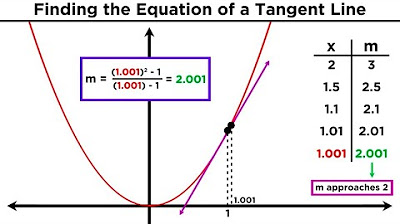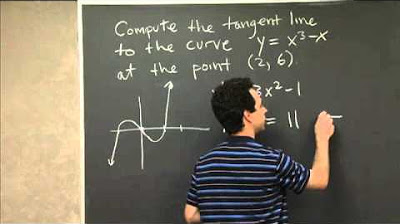Calculating slope of tangent line using derivative definition | Differential Calculus | Khan Academy
TLDRThe video script discusses the concept of finding the slope of a tangent line to a curve at a specific point, using the example of the function y = x^2. It explains the process of calculating the slope of a secant line between two points and then taking the limit as the points converge to find the slope of the tangent line. The demonstration involves finding the slope at x=3, concluding that the slope of the tangent line at that point is 6.
Takeaways
- 📊 The concept of finding the slope of a curve at a specific point is introduced, emphasizing the transition from a secant line to a tangent line.
- 🔍 The method involves approximating the tangent line's slope by considering the slope of a secant line that passes through a nearby point on the curve.
- 📐 The slope of the secant line is calculated using the change in y over the change in x, symbolized as Δy/Δx.
- 🔢 In the example, the curve y = x² is used to demonstrate how to find the slope at a specific point, with x = 3 highlighted.
- 📝 The notation change introduces Δx (delta x) as the variable representing the difference between the two x-values on the curve.
- 🧮 The slope of the secant line is then derived algebraically by calculating the difference in y-values and the difference in x-values between the two points on the curve.
- ⚖️ The process of taking the limit as Δx approaches 0 is explained, illustrating how it leads to finding the slope of the tangent line at the point.
- ✏️ The resulting slope of the tangent line at x = 3 for the curve y = x² is determined to be 6.
- 📉 This procedure outlines a foundational concept in calculus: the derivative, which represents the slope of the tangent line at a given point on a curve.
- 📚 The video sets the stage for a future discussion on generalizing the method to find the slope of the curve at any point, indicating an introduction to the concept of differentiation.
Q & A
What is the main concept discussed in the video?
-The main concept discussed in the video is the calculation of the slope of a tangent line to a curve at a specific point, which is found by taking the limit of the slope of a secant line as the points approach each other.
How is the slope of a secant line calculated?
-The slope of a secant line is calculated by finding the change in the y-values of two points on the curve and dividing it by the change in the x-values, which is the difference between the x-coordinates of the two points.
What is the difference between a secant line and a tangent line?
-A secant line connects two points on a curve, while a tangent line touches the curve at exactly one point. The slope of the tangent line at a point is the limit of the slopes of secant lines as the second point approaches the first point.
What is the function used as an example in the video?
-The function used as an example in the video is y = x^2.
At what x-value is the slope of the curve determined in the video?
-The slope of the curve is determined at the x-value of 3.
What is the slope of the tangent line at x = 3 for the function y = x^2?
-The slope of the tangent line at x = 3 for the function y = x^2 is 6.
How does the process of finding the slope of the tangent line involve limits?
-The process involves taking the limit of the slope of the secant line as the second point (delta x) approaches the first point (x), which gives the slope of the tangent line at that point.
What does the term 'delta x' represent in the context of the video?
-In the context of the video, 'delta x' represents the change in the x-value, which is the difference between the x-values of the two points used to find the slope of the secant line.
How does the slope of the secant line change as delta x becomes smaller?
-As delta x becomes smaller, the slope of the secant line approaches the slope of the tangent line, which is the desired value at a specific point on the curve.
What is the general formula for the slope of the secant line derived in the video?
-The general formula for the slope of the secant line derived in the video is (6 * delta x + delta x^2) / delta x.
What is the significance of the limit as delta x approaches 0 in the video?
-The significance of the limit as delta x approaches 0 is that it allows for the calculation of the exact slope of the tangent line at a specific point on the curve, as the secant line becomes indistinguishable from the tangent line.
Outlines
📈 Introduction to Calculating Slope and Derivatives
The paragraph begins with a recap of the previous video where the concept of slope, specifically the slope of a point or a curve at a certain point, was discussed. The method involved finding the slope between two points, one being the point in question and another slightly distant from it, to obtain the slope of the secant line. The process of taking the limit as the distant point approaches the point in question to find the slope of the tangent line, defined as the derivative of the function, was also explained. The video aims to apply this concept to a concrete example to better illustrate the process. A specific case is chosen to find the slope at a particular point on the curve y = x^2 where x equals 3. The explanation includes drawing the axes, identifying the curve, and the process of finding the slope of the tangent line at the given point.
📊 Deriving the Slope of the Secant and Tangent Lines
This paragraph delves into the process of finding the slope of the secant line and how it simplifies to find the slope of the tangent line at a specific point on the curve y = x^2 when x equals 3. The explanation includes the mathematical steps of finding the y-values of two points on the curve, one being (3,9) and the other being (3+delta x, 3+2*delta x+(delta x)^2), and then calculating the slope of the line passing through these two points. The simplification of the slope expression to 6 times the change in x plus the change in x squared, and then further simplifying it to 6 plus delta x, is detailed. The concept of taking the limit as delta x approaches 0 to find the slope of the tangent line is discussed, concluding that the slope at x=3 is 6. The paragraph ends with a note that a general formula for the slope at any point on the line will be presented in the next video.
Mindmap
Keywords
💡slope
💡point
💡curve
💡tangent line
💡limit
💡secant line
💡change in y
💡change in x
💡derivative
💡function
💡delta x
Highlights
The concept of finding the slope of a curve at a specific point was discussed.
The method involves finding the slope between a point on the curve and another point close to it, known as the secant line slope.
The slope of the secant line is calculated using the change in y-values divided by the change in x-values.
The example used in the transcript involves the function y = x^2 and finding the slope at the point where x equals 3.
A tangent line is introduced as a concept, which barely grazes the curve at a specific point and has the same slope as the curve at that point.
The derivative of a function is defined as the slope of the tangent line at a given point.
The technique used to find the slope at a particular point is demonstrated with the curve y = x^2 at x = 3.
The point (3, 9) is identified on the curve y = x^2, and another point (3 + delta x, (3 + delta x)^2) is used to find the secant line slope.
The slope of the secant line is expressed as (6 + delta x), showing the relationship between the slope and the change in x-values.
The limit concept is introduced to find the exact slope at a point by letting delta x approach 0.
As delta x approaches 0, the slope of the secant line approaches 6, which is the slope of the tangent line at x = 3.
The derivative of the function y = x^2 at the point x = 3 is found to be 6.
The transcript explains the process of finding the slope of a line at any given point on a curve through the concept of limits and derivatives.
The mathematical process of finding the slope of the tangent line is demonstrated in a step-by-step manner for better understanding.
The transcript provides a clear and detailed explanation of the relationship between secant lines, tangent lines, and derivatives.
The practical application of these concepts is shown by calculating the slope of a specific point on the curve y = x^2.
The transcript aims to make the abstract concepts of calculus more concrete and accessible through visual examples and step-by-step explanations.
Transcripts
Browse More Related Video

Understanding Differentiation Part 1: The Slope of a Tangent Line

Tangent Line to a Polynomial | MIT 18.01SC Single Variable Calculus, Fall 2010

Definition of the Derivative | Part I

Equation of a normal line [IB Maths AI SL/HL]

Implicit Differentiation - Finding Equation of Tangent Line

How To Find The Equation of the Normal Line
5.0 / 5 (0 votes)
Thanks for rating: